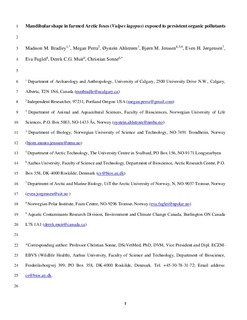| dc.contributor.author | Bradley, Madison M. | |
| dc.contributor.author | Perra, Megan | |
| dc.contributor.author | Ahlstrøm, Øystein | |
| dc.contributor.author | Jenssen, Bjørn Munro | |
| dc.contributor.author | Jørgensen, Even Hjalmar | |
| dc.contributor.author | Fuglei, Eva | |
| dc.contributor.author | Muir, Derek C.G. | |
| dc.contributor.author | Sonne, Christian | |
| dc.date.accessioned | 2018-08-30T07:01:18Z | |
| dc.date.available | 2018-08-30T07:01:18Z | |
| dc.date.created | 2018-08-29T14:13:18Z | |
| dc.date.issued | 2018 | |
| dc.identifier.citation | Science of the Total Environment. 2018, 646 1063-1068. | nb_NO |
| dc.identifier.issn | 0048-9697 | |
| dc.identifier.uri | http://hdl.handle.net/11250/2559947 | |
| dc.description.abstract | We investigated if dietary exposure to persistent organic pollutants (POPs) affect mandibular asymmetry and periodontal disease in paired male-siblings of Arctic foxes (Vulpes lagopus). During ontogeny, one group of siblings was exposed to the complexed POP mixture in naturally contaminated minke whale (Balaenoptere acutorostarta) blubber (n = 10), while another group was given wet feed based on pig (Sus scrofa) fat as a control (n = 11). The ∑POP concentrations were 802 ng/g ww in the whale-based feed compared to 24 ng/g ww in the control diet. We conducted a two-dimensional geometric morphometric (GM) analysis of mandibular shape and asymmetry in the foxes and compared the two groups. The analyses showed that directional asymmetry was higher than fluctuating asymmetry in both groups and that mandibular shape differed significantly between the exposed and control group based on discriminant function analysis (T2 = 58.52, p = 0.04, 1000 permutations). We also found a non-significantly higher incidence of periodontal disease (two-way ANOVA: p = 0.43) and greater severity of sub-canine alveolar bone deterioration similar to periodontitis (two-way ANOVA: p = 0.3) in the POP-exposed group. Based on these results, it is possible that dietary exposure to a complexed POP mixture lead to changes in jaw morphology in Arctic foxes. This study suggests that extrinsic factors, such as dietary exposure to POPs, may affect mandibular shape and health in a way that could be harmful to wild Arctic populations. Therefore, further studies using GM analysis as an alternative to traditional morphometric methods should be conducted for wild Arctic fox populations exposed to environmental contaminants. | nb_NO |
| dc.language.iso | eng | nb_NO |
| dc.publisher | Elsevier | nb_NO |
| dc.rights | Attribution-NonCommercial-NoDerivatives 4.0 Internasjonal | * |
| dc.rights.uri | http://creativecommons.org/licenses/by-nc-nd/4.0/deed.no | * |
| dc.title | Mandibular shape in farmed Arctic foxes (Vulpes lagopus) exposed to persistent organic pollutants | nb_NO |
| dc.type | Journal article | nb_NO |
| dc.type | Peer reviewed | nb_NO |
| dc.description.version | acceptedVersion | nb_NO |
| dc.source.pagenumber | 1063-1068 | nb_NO |
| dc.source.volume | 646 | nb_NO |
| dc.source.journal | Science of the Total Environment | nb_NO |
| dc.identifier.doi | 10.1016/j.scitotenv.2018.07.367 | |
| dc.identifier.cristin | 1605314 | |
| dc.relation.project | Norges forskningsråd: 153484 | nb_NO |
| dc.description.localcode | © 2018. This is the authors’ accepted and refereed manuscript to the article. Locked until 26.7.2020 due to copyright restrictions. This manuscript version is made available under the CC-BY-NC-ND 4.0 license http://creativecommons.org/licenses/by-nc-nd/4.0/ | nb_NO |
| cristin.unitcode | 194,66,10,0 | |
| cristin.unitname | Institutt for biologi | |
| cristin.ispublished | true | |
| cristin.fulltext | postprint | |
| cristin.qualitycode | 2 | |

